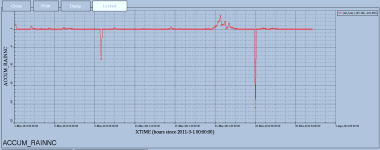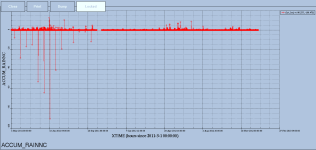gabriel_bromley
New member
Hello,
I ran a 4-km WRF simulation for multiple years and unfortunately did not catch some errors in the WRF output. In my WRF out files the simulation 'resets' around 10-12 days into a given month and then again around the 26th day of a given month. The issues are less severe it seems for continuous fields such as temperature, but precipitation seems to zero out and restart it's accumulation. When precipitation is post-processed these errors manifest as large negative values (see attached images). These occurrences are quite regular each month (indicating some issue in the model or input data) but appear to stop after a while.

Figure 1: Precipitation for March 2011

Figure 2: Precipitation from 2011-2013
What would you suggest to handle these errors? I'd like to conduct an analysis of convective precipitation. Should I just ignore these time steps or the entire day? It's hard to know with my expertise if the 'memory' of the atmospheric state progresses past these errors or is it just re-initializing from the ERA5 initial data? Is there a way to use this data while minimizing the effects of these corrupted time steps on results?
Data files that can be assessed are here:
/glade/p/univ/umsb0001/model_runs/control_umd/
Post-processed precipitation can be found here:
/glade/p/univ/umsb0001/model_runs/control_umd/derived
Thanks so much, please let me know if I can provide more information.
Gabe
I ran a 4-km WRF simulation for multiple years and unfortunately did not catch some errors in the WRF output. In my WRF out files the simulation 'resets' around 10-12 days into a given month and then again around the 26th day of a given month. The issues are less severe it seems for continuous fields such as temperature, but precipitation seems to zero out and restart it's accumulation. When precipitation is post-processed these errors manifest as large negative values (see attached images). These occurrences are quite regular each month (indicating some issue in the model or input data) but appear to stop after a while.

Figure 1: Precipitation for March 2011

Figure 2: Precipitation from 2011-2013
What would you suggest to handle these errors? I'd like to conduct an analysis of convective precipitation. Should I just ignore these time steps or the entire day? It's hard to know with my expertise if the 'memory' of the atmospheric state progresses past these errors or is it just re-initializing from the ERA5 initial data? Is there a way to use this data while minimizing the effects of these corrupted time steps on results?
Data files that can be assessed are here:
/glade/p/univ/umsb0001/model_runs/control_umd/
Post-processed precipitation can be found here:
/glade/p/univ/umsb0001/model_runs/control_umd/derived
Thanks so much, please let me know if I can provide more information.
Gabe
